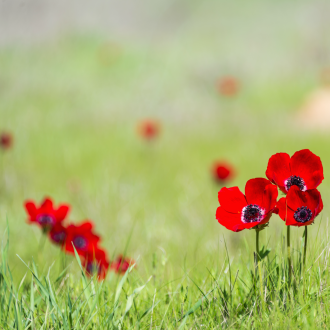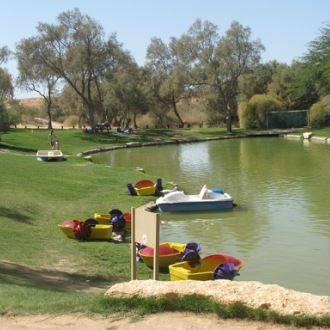A tour of the Old City of Be'er Sheva
Escursionismo
For directions, use the city map. You can get a map at the Be'er Avraham visitor center.
Be'er Avraham (Derech Hebron, KKL St., close to Nahal Be'er Sheva, it is a paid attraction).
According to tradition, this is the well dug by Avraham Aveinu. Abimelech tried to steal the well from Avraham (Bereishit 20), but, after proving his ownership of the well, they made a covenant of peace. This is where the well got its name from, meaning, the well where peace was 'sworn' between them. The site has been transformed into a new visitor center where an ancient well is a highlight, preserved in its original shape. It is at a depth of about 13.5 m, of which about 5 m are hewn in the rock, and the well is nourished by groundwater, with a circumference of 3.75 m and it is lined with stones all the way to the bottom. This well was an important meeting place for all the wandering tribes in the area. The Be'er Sheva municipality developed the area surrounding the well, built a wall around it, and paved the square.
You will start on KKL Street which was the main business center of the Ottoman-ruled city, which was established in 1900. The street is visible all along its length, starting with the Saraya building, which is the Turkish government house, now used by the Israel Police. It was built between 1900-1908, and it was the first public building in the city., The Turkish Governor also lived there in the early years, and, it was the site for the Turkish court and the Bedouin Tribal Court. The building was built very well with three arches in front, a large reception hall and offices on either side. On the other side of the street is the Negev Museum of Modern Art, built in 1906. This is a two-story building with an entrance foyer, three arches on the ground floor and a tile roof. The first floor served as a guest room and reception for the public, and the private residence of the governor and his family was on the second floor.
The entrance to the second floor was separate, and, in 1973 it was turned into a school for girls. At the beginning of 1950, the building was used by the municipality of Be'er Sheva. You will continue on Ha'atzmaut St. and reach Jama-the Great Mosque (now the Museum of Islamic and Near East Cultures), one of the most beautiful mosques in the country. It was established in 1906 and points directly south to Mecca. At the gate of the mosque, there is a wicket, where the imam passed. Above the gate is a round seal of the Turkish Sultan made of wood. The structure of the mosque is of a distinctly Turkish style, with a dome in its center, which rests on pillars and has many windows.
On the southern wall facing Mecca, there is the Mihrab, a semicircular niche in the wall of the mosque that indicates the qibla; that is, the direction of the Kaaba in Mecca and hence the direction that Muslims should face when praying. Across the road is Allenby Park. The park was scaped geometrically and at its center is a pillar that commemorates the Turkish victory over the British at the Azza battle (March-April 1917). After the fall of the city of Be'er Sheva in October 1917, the British placed a statue of their commander, General Allenby, sculpted by the artist Abraham Melnikov, who also created the lion statue in memory of Trumpeldor in Tel Hai. In 1938, an Arab gang blew up the statue, which seemed to be the symbol of British rule. Today, the name Allenby is engraved on it with the name ""Allenby 1917-1918."" You will continue on Ha'atzmaut St. to the Turkish government school for Bedouin children. This impressive building was intended to be an agricultural school with a boarding school for 200 children. Like the other Turkish public buildings in the city, this is a two-story building with a tiled roof, with three arches in the front, a central entrance and a large central hall on both sides, on two floors, living quarters and classrooms. The building was built in 1913, a year later, with the outbreak of the First World War, it became a military hospital.
After the War of Independence, the building served as the ""Soldiers' House"" and remained in military use even after the new ""Beit Hahayal"" moved to its new home. From here, you will continue to the Turkish railway station of Be'er Sheva (Rambam St.). The railway that arrived here was laid at the beginning of 1915: the importance of the city as the main station on the Turkish railroad line that extended from the Jaffa to Jerusalem, and all the way to Sinai, signified by the buildings and facilities that remain. There are a terminal, offices and residential quarters for workers, a workshop for the renovation of locomotives and train cars, a lumber mill, and a water tower, which is still visible at the site today.
The Turkish steam locomotives needed plenty of water at the road stations to fill their boilers and produce steam. At the end of the tour, you will return to your vehicle that was left at Abraham's Well, or, sit at one of the cafes that have opened in the Old City.
It is noteworthy that this is the only planned Ottoman city in Israel, and it is fairly preserved.
Written by: Dr. Shahar Shilo
Sentieri simili



The Oasis of the Western Negev

Attrazioni nelle vicinanze







The Train Yard Engine 70414
Ristoranti nelle vicinanze


Joe "Menta" - Dalrom


Burgerim- Beer-Sheva



